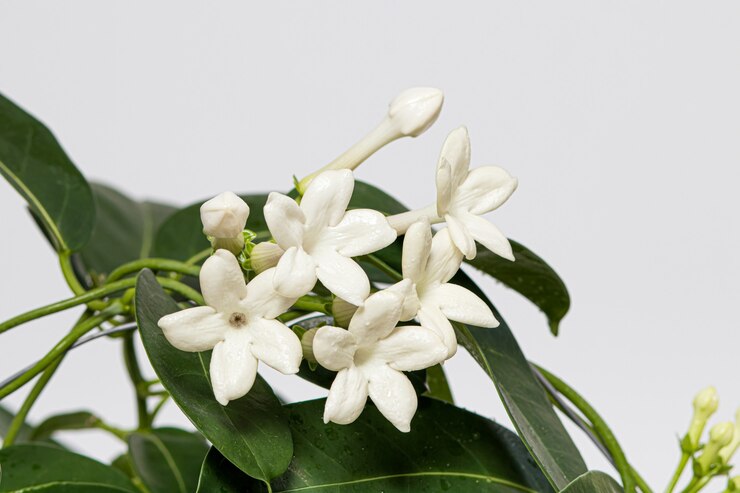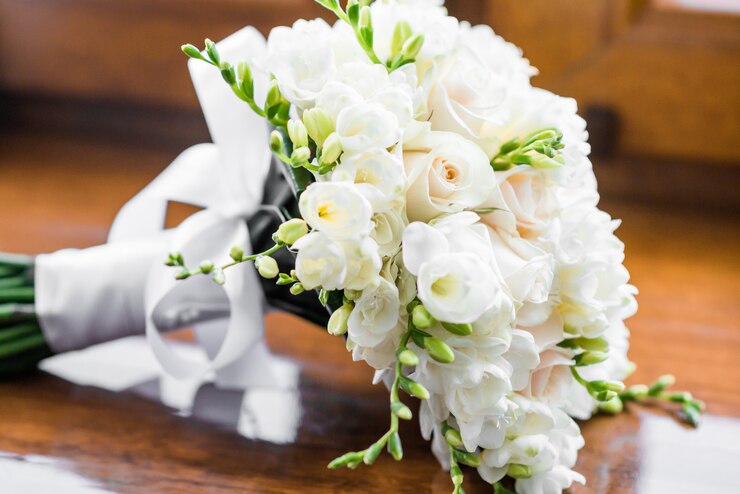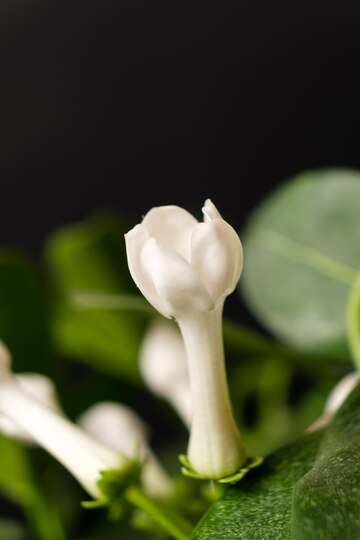Stephanotis, also known as Madagascar Jasmine or Bridal Veil, is a beautiful and fragrant flowering plant that captivates gardeners and indoor plant enthusiasts alike.
Its lush glossy, dark green leaves that are oval in shape and clusters of pure white, star-shaped flowers make it a popular choice for weddings and special occasions because of its symbolism of marital happiness.
Stephanotis is a climbing plant that can reach heights of 10 feet or more. The plant produces beautiful, waxy, and highly scented flowers.
Stephanotis (Stephanotis floribunda) belongs to the Apocynaceae family and is native to Madagascar and other parts of Southeast Asia.
The name “stephanotis” is derived from the Greek words “Stephanos”, meaning “crown”, and “otus”, meaning “ear”, which describes the flower’s crown-shaped appearance with delicate, ear-like petals.
This beautiful and fragrant flower has long been associated with weddings, symbolizing marital bliss, happiness, and purity.
| Characteristic | Description |
|---|---|
| Scientific Name | Stephanotis floribunda |
| Common Name | Madagascar Jasmine, Waxflower |
| Family | Apocynaceae (Dogbane family) |
| Origin | Madagascar, Southeast Asia, Australia |
| Type | Evergreen, woody vine |
| Foliage | Glossy, dark green leaves |
| Flowers | Clusters of waxy, tubular, white, fragrant flowers |
| Fragrance | Strong, sweet fragrance, especially in the evening |
| Light Requirements | Bright, indirect light; can tolerate some direct sunlight |
| Watering | Keep soil consistently moist; allow the top inch to dry out between waterings |
| Soil | Well-draining potting mix, rich in organic matter |
| Humidity | Prefers higher humidity levels, benefits from occasional misting |
| Temperature | Warm temperatures; protect from drafts and cold extremes |
| Propagation | Stem cuttings, layering, air layering |
| Common Uses | Indoor ornamental plant, often grown in hanging baskets or trained on trellises |
| Special Features | Fragrant flowers, popular choice for weddings and special occasions |
The Right Location of Stephanotis:
Selecting the right location for your Stephanotis plant is crucial for its overall health and growth. Ideally, it should be placed in an area with partial shade or indirect sunlight.
Avoid placing it in direct sunlight for extended periods as it may lead to leaf burn and hinder flower production.
Soil and Water Requirements Stephanotis:
Stephanotis thrives in well-draining, fertile soil that retains moisture without becoming waterlogged. A mix of potting soil, perlite, and orchid bark is an excellent choice for potted Stephanotis plants.
When watering, ensure that the soil is evenly moist but not soggy, as overwatering can lead to root rot.
Light and Temperature Needs:
Stephanotis prefers a warm and humid environment with temperatures between 65°F to 75°F (18°C to 24°C).
It is essential to protect the plant from cold drafts and sudden temperature drops, which can cause stress and affect its growth.
Pruning and Training Tips:
Regular pruning is essential for Stephanotis to maintain its shape and encourage new growth.
Remove dead or yellowing leaves and trim back unruly vines to control the plant’s size. Training the vines to climb a trellis or support will enhance their appearance and prevent tangling.
Propagation Methods:
There are two primary methods for propagating Stephanotis: stem cuttings and layering. Stem cuttings involve taking a healthy cut from the plant and encouraging it to root in water or soil.
Layering, on the other hand, involves burying a portion of the stem in the soil until it develops roots.
Common Pests and Diseases:
Like all plants, Stephanotis is susceptible to pests and diseases. Keep an eye out for common issues like aphids, mealybugs, and spider mites.
Regularly inspect the plant and take prompt action to address any infestations or infections.
Fertilizing Your Stephanotis:
To promote healthy growth and abundant flowering, it’s essential to fertilize your Stephanotis regularly.
Use a balanced, water-soluble fertilizer during the growing season, following the manufacturer’s instructions for application.
Repotting the Plant:
As your Stephanotis grows, it may outgrow its current container. Repotting should be done every 2 to 3 years or when the plant becomes root-bound.
Choose a slightly larger pot with good drainage, and be gentle with the roots during the repotting process.
Winter Care for Stephanotis:
During the colder months, Stephanotis may enter a period of dormancy. Reduce watering and avoid fertilizing during this time.
If you live in a region with frost or chilly winters, consider bringing the plant indoors or providing adequate protection from freezing temperatures.

Types of Stephanotis
Here are some notable types and variations:
Stephanotis floribunda:
Characteristics: The standard Stephanotis floribunda is a twining vine with leathery, dark green leaves and clusters of waxy, white, tubular flowers. It is highly fragrant and often used in bridal bouquets and corsages.
Stephanotis floribunda ‘Variegata’:
Characteristics: Some cultivars may exhibit variegation in the leaves, featuring lighter or cream-colored patterns alongside the typical dark green.
Stephanotis floribunda ‘Rosea’:
Characteristics: ‘Rosea’ is a variation that may produce flowers with a pinkish tint, adding a subtle touch of color to the traditional white blooms.
Stephanotis floribunda ‘Variegated Compacta’:
Characteristics: This variation combines variegation in the leaves with a more compact growth habit, making it suitable for smaller spaces or container gardening.
Stephanotis floribunda ‘Exotica’:
Characteristics: ‘Exotica’ is sometimes used to describe a more exotic or unique form of Stephanotis floribunda, possibly with different growth characteristics or flower attributes.
Characteristics and Appearance
Stephanotis flowers are renowned for their captivating beauty and enchanting fragrance. Here are some key characteristics:
- Blossoms: The flowers are small, waxy, and star-shaped, typically growing in clusters. They have a pristine white color, exuding elegance and sophistication.
- Fragrance: One of the most alluring features of Stephanotis flowers is their sweet, intoxicating fragrance. The scent is often described as a blend of jasmine, gardenia, and hyacinth, making it a popular choice for bridal bouquets and corsages.
- Foliage: The glossy, dark green leaves of the Stephanotis plant serve as a perfect backdrop to the pristine white blossoms, creating a visually striking contrast.
- Vine-Like Growth: Stephanotis plants are climbers by nature, using aerial roots to attach themselves to trellises or supports. This makes them an ideal choice for adorning archways and trellises in wedding decorations.
Stephanotis Flowers into Your Wedding
Stephanotis flowers are a popular choice for weddings due to their timeless beauty and significance. Here are some creative ways to include them in your wedding:
- Bridal Bouquet: Create a classic, elegant bridal bouquet using Stephanotis as the focal flower. Pair it with greenery or delicate baby’s breath for a stunning arrangement.
- Boutonnieres: Use single Stephanotis blossoms for the groom’s boutonniere, symbolizing the purity of love.
- Corsages: Adorn the mothers and grandmothers with Stephanotis corsages to honor them on your special day.
- Venue Decorations: Decorate archways, trellises, and aisles with lush Stephanotis vines to add a touch of romance to your wedding venue.
- Centerpieces: Incorporate Stephanotis blooms into your table centerpieces for an enchanting and fragrant ambiance.
- Cake Decorations: Crown your wedding cake with delicate Stephanotis flowers for a refined and sophisticated look.

Symbolism and Meaning of Stephanotis Flowers
Beyond their captivating beauty and delightful fragrance, Stephanotis flowers carry deep symbolism and meaning. They represent:
- Marital Bliss: Stephanotis is often associated with happy marriages, making it a perfect addition to weddings.
- Commitment: The intertwined vines symbolize the bond between two people, signifying commitment and unity in a marriage.
- Purity and Innocence: The pristine white color of the blossoms symbolizes purity, innocence, and a fresh start in a new journey together.
Conclusion
Stephanotis flowers are a true embodiment of grace, elegance, and love, making them an exceptional choice for weddings and other special occasions.
With their captivating fragrance and timeless beauty, these enchanting blossoms are sure to add a touch of magic to your big day.
| Faqs Q: Can I grow Stephanotis in a hanging basket? Yes, Stephanotis can be grown in a hanging basket, allowing its vines to cascade gracefully. Q: Does Stephanotis require support for climbing? Yes, Stephanotis needs support, such as a trellis or arbor, for its vines to climb and grow vertically. Q: Can I use tap water to irrigate my Stephanotis? It is best to use filtered or distilled water to avoid harmful chemicals present in some tap water that can damage the plant. Q: How long does it take for Stephanotis cuttings to root? Stephanotis cuttings usually take 3 to 6 weeks to develop roots when propagated in water or soil. Q: Can I keep Stephanotis outdoors all year round? Stephanotis can be kept outdoors year-round in tropical or subtropical regions with warm temperatures. In colder climates, it’s best to bring it indoors during winter. |

